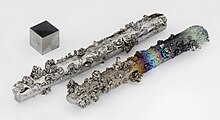Tungsten, 74 Pronunciation / ˈ t ʌ ŋ s t ən / (TUNG -stən Alternative name wolfram, pronounced: / ˈ w ʊ l f r əm / (WUUL -frəm Appearance grayish white, lustrous Standard atomic weight A r, std (W) 7002183840000000000♠ 183.84(1)[ ᱑]
Atomic number (Z ) 74 Group group 6 Period period 6 Block d-block Element category Transition metal Electron configuration [Xe ] 4f14 5d4 6s2 [ ᱒] Electrons per shell
2, 8, 18, 32, 12, 2 Phase at STP solid Melting point 3695 K (3422 °C, 6192 °F) Boiling point 6203 K (5930 °C, 10706 °F) Density (near r.t. ) 19.3 g/cm3 when liquid (at m.p. ) 17.6 g/cm3 Heat of fusion 52.31 kJ/mol [ ᱓] [ ᱔] Heat of 774 kJ/mol Molar heat capacity 24.27 J/(mol·K) pressure
P (Pa)
1
10
100
1 k
10 k
100 k
at T (K)
3477
3773
4137
4579
5127
5823
Oxidation states −4, −2, −1, 0, +1, +2, +3, +4 +6 acidic oxide) Electronegativity Pauling scale: 2.36 energies 1st: 770 kJ/mol 2nd: 1700 kJ/mol Atomic radius empirical: 139 pm Covalent radius 162±7 pm Spectral lines of tungstenNatural occurrence primordial Crystal structure (bcc) Speed of sound thin rod 4620 m/s (at r.t. ) (annealed) Thermal expansion 4.5 µm/(m·K) (at 25 °C) Thermal conductivity 173 W/(m·K) Electrical resistivity 52.8 nΩ·m (at 20 °C) Magnetic ordering paramagnetic [ ᱕] Magnetic susceptibility +59.0·10−6 cm3 /mol (298 K)[ ᱖] Young's modulus 411 GPa Shear modulus 161 GPa Bulk modulus 310 GPa Poisson ratio 0.28 Mohs hardness 7.5 Vickers hardness 3430–4600 MPa Brinell hardness 2000–4000 MPa CAS Number 7440-33-7 Discovery Carl Wilhelm Scheele (1781) First isolation Juan José Elhuyar and Fausto Elhuyar (1783) Named by Torbern Bergman (1781)
| references
References
These references will appear in the article, but this list appears only on this page.
↑ Meija, Juris; Coplen, Tyler B.; Berglund, Michael; Brand, Willi A.; De Bièvre, Paul; Gröning, Manfred; Holden, Norman E.; Irrgeher, Johanna; Loss, Robert D.; Walczyk, Thomas; Prohaska, Thomas (2016). "Atomic weights of the elements 2013 (IUPAC Technical Report)" . Pure and Applied Chemistry 88 (3): 265–91. doi :10.1515/pac-2015-0305 ↑ Berger, Dan. "Why does Tungsten not 'Kick' up an electron from the s sublevel ?" . Bluffton College, USA. ↑ Lide, David R., ed. (2009). CRC Handbook of Chemistry and Physics Boca Raton, Florida : CRC Press . p. 6-134. ISBN 978-1-4200-9084-0 ↑ Tolias P. (2017). "Analytical expressions for thermophysical properties of solid and liquid tungsten relevant for fusion applications". Nuclear Materials and Energy . 13 : 42–57. arXiv :1703.06302 Bibcode :2017arXiv170306302T . doi :10.1016/j.nme.2017.08.002 . ↑ Lide, D. R., ed. (2005). "Magnetic susceptibility of the elements and inorganic compounds" (PDF) . CRC Handbook of Chemistry and Physics (86th ed.). Boca Raton (FL): CRC Press. ISBN 978-0-8493-0486-6 ↑ Weast, Robert (1984). CRC, Handbook of Chemistry and Physics . Boca Raton, Florida: Chemical Rubber Company Publishing. p. E110. ISBN 978-0-8493-0464-4 ↑ Berger, Dan (February 25, 2000). "Why does Tungsten not 'Kick' up an electron from the s sublevel ?" . Bluffton College, USA.
Lua error in ᱢᱳᱰᱩᱞ:Documentation at line 144: message: type error in message cfg.container (string expected, got nil).


